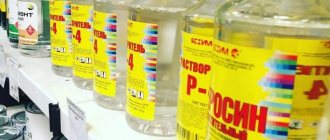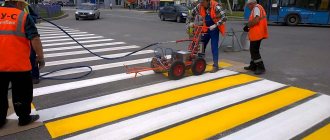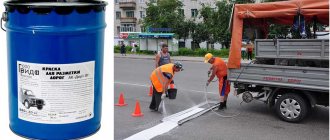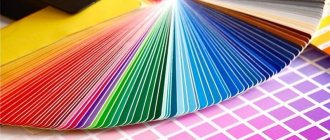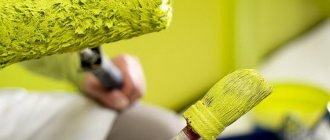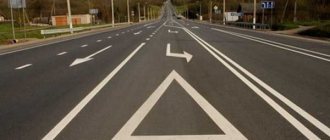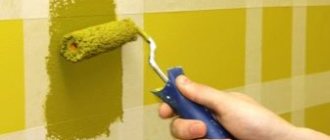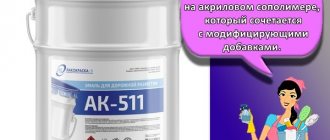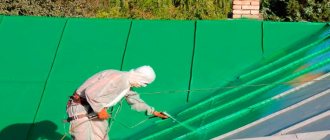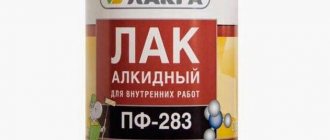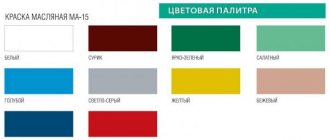Today, the most popular paint and varnish material for applying road markings is AK 511 paint. This is a one-component specialized composition that is used for permanent and temporary marking of roadways, pedestrian roads, as well as on general-purpose concrete pavements.
Often, signs and directional arrows on paths in parking areas, workshops or warehouses are applied using AK 511.
Purpose of paint
Road marking enamel AK-511 is produced in accordance with GOST R 52575-2006 and is used for drawing safety lines on public roads. The enamel is designed for those routes where there is intense and moderate traffic, it is excellent for the following coatings:
- cement concrete,
- asphalt concrete.
Horizontal road markings made using paint are also widely used in areas near warehouses, parking lots, parking lots, and airfields. The black material is used not for marking roads, but for demarcating old markings (painting them over). To provide the marking with reflective properties, additives are introduced into the enamel - special glass beads. According to GOST, it is permissible to apply the product on the roadway of categories 1–4.
Composition and properties of the material
The marking enamel contains various pigments and fillers diluted on an acrylic copolymer with the addition of modifying additives. The properties of the material are indicated in the certificate of conformity and other technical documentation. Here are the main ones:
- high brightness coefficient,
- ensuring excellent visibility for drivers in the dark and during daylight hours,
- quick drying - in just 15-30 minutes,
- good adhesion to the surface,
- high wear resistance and hiding power,
- no damage due to sudden temperature changes.
Important! The markings applied to the road will last a long time - they are resistant to water, dirt, fuels and lubricants and other chemicals and salts.
When glass beads are added, the markings are clearly visible even in bad weather. This helps reduce accidents on the road.
Characteristics of the product
Technical characteristics reflect the main parameters of AK-511 paint, which should be studied before using it:
- the coating created is smooth, even, with a uniform texture, without foreign inclusions,
- viscosity according to the device viscometer VZ-246 at a temperature of +20 degrees – 80–160 s,
- dry residue share – 75%,
- coating adhesion – 1 b,
- the time for complete drying of the enamel at a temperature of +20 degrees is 30 minutes,
- brightness coefficient – 70%,
- material density – 1.4 g/sq. cm,
- degree of grinding – 70 microns,
- lightfastness of the coating – 8 hours,
- resistance to water - 72 hours, to sodium chloride solution - 72 hours, to gasoline - 20 minutes.
Color solutions
AK-511 paint is white, according to GOST it should not have any extraneous shades, it is matte. AK-511 Sprinter enamel is also produced, to which colored pigments are added. Paint colors – yellow, orange, black, red.
Technical characteristics of AK-511 enamel
The quality of the enamel corresponds to that stated in GOST; its characteristics according to various parameters, presented in the table below, allow us to guarantee a durable, bright, high-quality coating for up to 6 months.
| Appearance of the coating | According to the control sample |
| Enamel color | White, shade is not standardized |
| Mass fraction of non-volatile substances,% | 75 ± 3 |
| Conditional viscosity according to a VZ-246 viscometer with a nozzle diameter of 4 mm at a temperature of (20.0 ± 0.5) °C, s | 100–160 |
| Degree of grinding, microns, no more | 70 |
| Drying time to degree 3 at temperature (20 ± 2) °C and relative humidity (65 ± 5)%, min, no more | 20 |
| Coating adhesion, points, no more | 1 |
| Conditional light resistance of the coating, h, not less | 8 |
| Resistance of the coating to static influence, not less than a) water at a temperature of (20 ± 2) °C b) 3% aqueous solution of sodium chloride at a temperature of (0 ± 2) °C c) gasoline, min | 72 72 20 |
| Coating strength to abrasion, kg/µm, not less | 0,6 |
| Brightness coefficient,%, not less | 80 |
| Density, g/cm3, more | 1.6 |
Subject to storage conditions and rules of use, the enamel is guaranteed to have the specified properties. The enamel is produced according to TU 2316-156-05011907-98.
Preparing for work
You should work with enamel only in dry weather. The coating is cleaned as much as possible from dirt and dust. Air temperature +5...+30 degrees, air humidity does not exceed 85%.
Before application, mix the paint well until the sediment completely disappears. To eliminate bubbles after mixing, leave the material for another 10 minutes. Various solvents can be used for dilution. How to dilute is indicated in the instructions for use - you can use toluene, P-4, acetone, ethyl acetate, butyl acetate. The amount of solvent from the total mass of the material does not exceed 15%. If there is a break in work, the product must be tightly closed and stirred again before work.
Preparatory activities
Before painting, it is necessary to clean the surface from dust, debris and various types of contaminants. Since AK-511 is a paint with acrylic additives, it is recommended to apply it to a dry surface.
Before application, AK 511 enamel must be stirred with a construction mixer to achieve uniformity of the composition. Leave it alone for 5-7 minutes so that the air bubbles disappear from the surface.
Initially, read the description of all the characteristics and properties of the paint. Pay attention to the degree of solubility, it should be up to 15%. If the paint is very thick, it should be diluted using solvents (acetone, toluene or P-4).
Before you start painting, put on overalls and a respirator. This way you will protect your body and face from toxic substances from the coloring material.
If you plan to paint in several stages (while taking breaks), cover the container with paint tightly so that it does not begin to harden. Before starting work, mix again until smooth and let stand until bubbles disappear.
Road markings can be applied using brushes or a roller.
Application methods
The product can be applied with a roller, brush, or spray. The distance from the spray nozzle to the surface is 20–30 cm. The operating mode is selected depending on the brand of the device. Usually 1-2 layers of paint are enough. Consumption is 400–600 g/sq.m. m. Glass beads are mixed into the paint at the rate of 300 g/sq. m of coverage.
Application to wet road surfaces is not allowed, and the material must not be diluted with water, gasoline, or kerosene. Wash equipment with toluene. Drivers will be able to use the road 15–30 minutes after applying the enamel, depending on the air temperature (the higher it is, the faster the coating dries).
Technology for applying materials for road markings AK-511, AK-505, EP-5155
In recent years, due to a significant increase in the number of cars and trucks on the country's roads, the role of technical means ensuring the organization of traffic has increased. The quality and functionality of road markings play an important role in this matter.
To obtain high-quality, durable markings, two basic conditions must be met:
- use of high quality materials;
- high-quality execution of marking work.
High-quality application of road markings must be preceded by two important measures: an assessment of the level of operational load of the road on which the markings will be applied and, as a result, the correct choice of paint and varnish material.
Assessing the level of operational load of a highway involves taking into account the influence of a whole set of factors on the condition of the roadway: traffic intensity in a given section, width of the roadway, type and quality of road surface, purpose and location of markings, seasonal temperature changes, etc. All these factors are assessed in points and, based on the sum of points, the level of operational load of the road is determined.
Below is an example of selecting material for road markings.
1. First of all, the traffic intensity of the route is assessed (Table 1):
| Traffic intensity, vehicles/day | Points |
| less than 6000 | 1 |
| from 6000 to 10000 | 2 |
| from 10000 to 20000 | 4 |
| more than 20000 | 6 |
In our example, we take the traffic intensity from 6,000 to 10,000 cars per day, which corresponds to 2 points.
2. Then, according to Table 2, the width of the roadway is estimated:
| Width of the roadway, m | Lane width, m | Points |
| until 6 | until 3 | 3 |
| from 6 to 7.5 | from 3 to 3.75 | 1 |
| more than 7.5 | more than 3.75 | 0 |
We take the width of the roadway to be 6 - 7.5 meters, i.e. 1 point.
3. Next, we evaluate the purpose and location of the markings (Table 3):
| Type of marking applied | Points |
| Edge lines | 0 |
| Marking parking spaces | 2 |
| Marking in places of descent or ascent | 2 |
| Centerlines | 4 |
| Dividing lines of lanes outside the city limits, lines of transverse markings, the passage of which is not carried out constantly | 5 |
| Transverse marking lines that are constantly used for travel | 10 |
The type of marking applied is center lines, which corresponds to 4 points.
4. In accordance with Table 4, we evaluate the type and quality of the road surface:
| Characteristics of the road surface | Points |
| Smooth asphalt concrete road surface without visible damage with roughness: | |
| 0 |
| 1 |
| Smooth cement concrete road surface without visible damage with roughness: | |
| 2 |
| 3 |
Let the surface be asphalt concrete with natural roughness - 0 points.
5. We evaluate the influence of seasonal operating factors:
| Seasonal operating factors | Points |
| Absent | 0 |
| Use of de-icing mixtures | 1 |
| Use of mechanical road cleaning equipment | 2 |
| Transition of air temperature through 0° C | 3 |
6. According to Table 6, we take into account the influence of other factors:
| Type of marking applied | Points |
| Absent | 0 |
| Markings at road intersections at one level | 3 |
| Marking on horizontal curves and turns with a radius of up to 70 m | 4 |
| Dividing lines of lanes within the boundaries of a populated area, travel through which is carried out constantly | 10 |
To simplify the problem, we will neglect seasonal and other operating factors. Then the sum of points is:
Σ = 2 + 1 + 4 + 0 + 0 + 0 + 0 = 7.
7. The level of operational load on the road section is determined taking into account the amount of points obtained according to Table 7 below:
| Sum of points | Level of operational load of the road section |
| 1-5 | 1 |
| 6-10 | 2 |
| 11-15 | 3 |
| 16-20 | 4 |
| More than 20 | 5 |
8. Now, knowing the level of operational load on the highway, you can begin selecting the optimal paint and varnish material:
| Marking material | Level of operational load of the road section | Functional durability of markings, months, not less |
| Paint, enamel | time marking | not standardized |
| 1 | 18 | |
| 2 | 12 | |
| 3 | 6 | |
| Sprayplastic | 2 | 18 |
| 3 | 12 | |
| 4 | 6 | |
| Cold plastic | 2 | 24 |
| 4 | 18 | |
| 5 | 12 |
Those. To mark our section of the road, it is necessary to use paint and varnish material or spray plastic.
More details on the principles of selecting paints and varnishes for road markings can be found in [1, 2].
The second, no less important preliminary stage is the incoming control of marking materials, which should begin with checking the availability of the necessary regulatory and technical documentation accompanying the material: technical specifications, technical passport for the supplied batch of material, sanitary-epidemiological report and quality certificate.
Incoming quality control of the material for compliance with the requirements of regulatory and technical documentation (GOST R 51256-99 and technical specifications for the material) is carried out by a specialized independent laboratory that has the appropriate accreditation, the necessary methods, equipment and specialists.
Upon completion of the preparatory work, they begin directly to apply road markings. The conditions and technology for applying markings are described in detail in a number of methodological documents [1, 2, 3, 4, 5].
The road marking technology consists of several stages:
- Preparing the road surface for painting;
- Preparation of paint and varnish material for application;
- Preliminary marking of the road surface;
- Applying primer (if necessary)
- The actual application of road markings (including glass beads);
- Washing equipment and tools.
Applying markings begins with preparing the surface of the road surface: demarcating (removing) the remains of old markings that have become unusable, performing patching or major repairs to the pavement, and filling cracks. The coating must be cleaned, washed and dried. Then climatic conditions are monitored for compliance with the recommendations of the instructions for use of the material. Recommended climatic conditions for applying markings: air and road surface temperature from +5 to +35 °C and relative air humidity not higher than 85%. Fresh asphalt and concrete must be kept at a temperature of at least 10 °C for 7 - 10 days, and after rain the surface must be allowed to dry. It is highly undesirable to apply it to the road surface during rain.
Preliminary markings are applied manually or using a special marker bracket installed on a marking machine. The technology for applying preliminary markings includes determining control points, tensioning the cord and applying points that fix the design position of lines and symbols of road markings. Applying preliminary markings must begin with the center lines, and then apply lines parallel to them that separate the lanes.
Subpriming, including the choice of material and technology, is carried out in accordance with the recommendations of the manufacturer of the marking material.
Next, the paint and varnish material is prepared, which consists of diluting it to working viscosity and loading it into the container of the marking machine. Enamel EP-5155
diluted
with solvent 646
(GOST 18188), paints and enamels based on solvent-borne acrylic copolymers are diluted to working viscosity, usually with toluene, butyl acetate (or a mixture of them in a 1:1 ratio), or
solvent
R-4 or
acetone ,
water-dispersed marking materials with water .
The degree of dilution enamels
to working viscosity depends on the application method (marking machine, brush, roller), but usually does not exceed 10% by weight of the material. Before use, the paint and varnish material must be thoroughly mixed. The measures for the preparation of paints and varnishes are described in more detail in the relevant methodological recommendations [6], as well as in the instructions for the use of paints and varnishes and the operation of the corresponding marking machines.
The increase in the production of domestic acrylic copolymers has led to the emergence of paints and varnishes with a high dry residue (more than 70%), while the wear resistance of the paint has increased by 2-10 times. These are materials such as AK-503
,
AK-505
,
AK-511, AK-513, AK-540, AK-585
and others.
Markings with paints (enamels) are applied using special marking machines by pneumatic or airless spraying in accordance with the regulations and operating instructions for the machine, or manually using a stencil using a paint sprayer, brush or roller.
To improve the visibility of markings and create a retroreflective effect, reflective glass beads (microspheres) are introduced into the paint.
The requirements for glass beads are presented below:
| Indicator name | Technical requirements |
| 1. Appearance | Transparent microspheres containing no more than 5% gas inclusions and not sticking to each other. |
| 2. Content of technological residues (fragments), %, no more | 5 |
| 3. Content of non-spherical particles, %, no more | 20 |
| 4. Content of main fractions, %, not less | 50 |
| 5. Minimum size, microns | 50 |
| 6. Maximum size, microns | 1200 |
| 7. Refractive index | 1,50 – 1,65 |
| 8. Density, g/cm 3 | 2,4 – 2,6 |
| 9. Surface character | hydrophobic |
The most optimal size of glass beads is 70 – 160 microns, although the use of microspheres with a diameter from 100 to 600 microns is allowed (STO MShS-01-03 “Retroreflective elements (glass beads) for road markings”). The recommended amount of glass beads is 25 - 30% by weight of the paint and varnish material.
METHODS OF INTRODUCING GLASS BEADS INTO PAINT
• introduction of paint and varnish material into the interior in an amount of no more than 30%;
• sprinkling on top of freshly applied road markings in an amount of 200 – 300 g/m2;
• combination of the above methods.
Application of glass beads
application to the road marking surface is carried out automatically using a special pneumatic distributor included in the set of marking machines. Before starting work, microspheres are loaded into a special container of the marking machine, from where they are fed under pressure through a special nozzle onto the surface of the freshly applied, unformed marking. When applying the marking material, glass beads under air pressure are fed through a separate nozzle onto the surface of the unformed marking line. When manually applying road markings, glass beads are also applied manually. When applying paint with a roller, microballs are not used.
To achieve the maximum effect of retroreflection, it is necessary that the glass beads are half immersed in the paint and varnish material. In this case, good retention of microspheres by the marking material is achieved, and optimal refraction and reflection of light is achieved. If the glass beads protrude from the material by more than 50%, they are easily “knocked out” by the wheels of vehicles. When glass beads are immersed more than halfway in the marking material, the reflected light flux decreases sharply.
Immediately after completion of work, it is necessary to wash the equipment and painting tools. Washing is usually carried out with a solvent used to dilute the enamel. After washing the equipment and tools, the cleaning solvent can be used for its intended purpose. Thus, on the one hand, solvent losses are reduced, and on the other, the issue of its disposal is resolved.
In conclusion, it only remains to add that all work on marking road surfaces must be carried out by qualified personnel.
Video on the topic:
“High-quality road paint for road markings and materials for its application AK-503, AK-505, AK-511, AK-513, AK-540, AK-585”
Along with this read:
“The influence of pigments and fillers on the abrasion resistance of road marking coatings”
“Comparison of technical indicators of road marking paints Stollreflex D1163 (Austria) and AK-513 (Khimtek PA LLC)”
"Life lines. Road markings."
Storage and Security
The shelf life of the product is 6 months. It should be stored in a tightly sealed container, protected from water and direct sunlight. Storage temperature – within –30…+40 degrees.
Security measures are as follows:
- the paint is toxic due to the presence of solvents in the composition, hazard class – 3, maximum permissible concentration in the air of the working area – up to 150/50 mg/cu. m,
- workers must wear gloves or apply protective pastes to the skin of their hands,
- Respiratory organs must be protected with respirators or gas masks,
- fire safety measures must be strictly observed - no smoking, no sparks,
- In case of fire, extinguish with sand, asbestos blankets, foam, water.
The material is produced by Khimprom-M LLC. You can also find paint from . The enamel is produced in containers of 20, 27, 55 liters.
